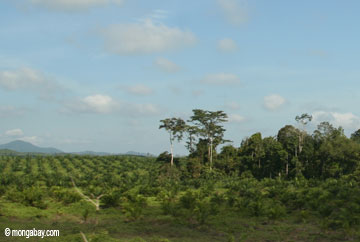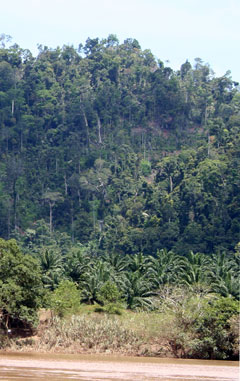Dutch plan restricts biofuels that damage environment
Dutch plan restricts biofuels that damage environment
mongabay.com
April 29, 2007
The Netherlands has proposed a system to reduce the environmental impact of biofuels production. The country becomes the first in the world to establish such guidelines.
Environmentalists have expressed increasing concern for the establishment of energy crops in biodiverse and carbon-rich ecosystems like the peatlands of Indonesia and the Amazon rainforest. They say that conversion of these forests for oil palm and soybeans is threatening endangered species and worsening global warming. Further, they warn, demand for such biomass energy products is driving up prices for food crops.
The new Dutch initiative, put forth by a commission led by Environment Minister Jacqueline Cramer, draws up a framework by which companies can measure the sustainability of crops used for biofuels.
“Biomass production should not come at the expense of environmental damage and it should lead to less emissions of greenhouses gases than fossil fuels,” the report said.

Oil palm plantation in Malaysia. Malaysia is currently the world’s largest producer of palm oil, though Indonesia is soon expected to surpass it in production. Photo by Rhett A. Butler |
“The framework evaluates emission reduction compared with fossil fuels and whether the crops supplant other land uses such as food production,” reported the Associated Press. “It also looks at whether the crops reduce biodiversity, damage the environment or use pesticides.”
The system would initially be voluntary in order to skirt World Trade Organization (WTO) regulations.
“As long as it’s a voluntary system, we don’t have a problem,” Minster Cramer told the Associated Press.
A draft version of the initiative sets forth criteria for biofuels production including the impacts on greenhouse gas emissions, local food supplies and prices, biodiversity, water supplies, soil quality, and social well-being of workers–important measures given that soy and oil palm cultivation have increasingly been linked with worker abuse, land rights violations, and environmental degradation.

Photo by Rhett A. Butler |
Environmental groups expressed guarded enthusiasm for the proposal.
“[We support] the use of bio-fuels as an alternative to fossil fuels, as long as it can be proved that these bio-fuels are truly sustainable,” said Wetlands International, a Dutch-based organization that has been instrumental in highlighting problems associated with unsustainable palm oil production. “Although the NGO is relieved that palm oil from peatlands is no longer supported in the Netherlands, Wetlands International supports other NGOs in their criticisms of some other elements of the report.”
Wetlands International goes on to say that the commission is too lax with regard to deforestation for energy crops and addressing poverty concerns.
“Support to bio-fuel production displaces food production in some areas and leads to higher food prices,” said the group. “There are no criteria presented to ban bio-fuels that do compete with food production in developing countries.”
Greenpeace and Environment Defense were also critical according to the Associated Press (AP).
“In essential areas, the plans fall short,” the groups told the AP. “Rain forests can still be cleared for new plantations.”
Related articles
Dutch will demand rainforest-friendly palm oil. In a report scheduled to be released today, the Dutch government will outline criteria for growing biofuels in a more sustainable manner. The guidelines will be closely watched by the rest of Europe, which is currently struggling with the environmental pros and cons of large-scale energy crop production, especially in ecologically-sensitive areas like the Amazon and Indonesian rainforests.
Eco-friendly palm oil could help alleviate poverty in Indonesia. Palm oil is quite obviously not a failure as a biofuel—it is derived from perhaps the most productive energy crop on the planet. A single hectare of oil palm may yield nearly 6,000 liters of crude biodiesel. In comparison, soybeans and corn generate only 446 and 172 liters per hectare, respectively. The problem with palm oil is not its yield, but how it is produced. Presently much of the world’s palm oil is coming out of the forests of Southeast Asia—increasingly in the biodiverse rainforests of Indonesia. Oil-palm cultivation has expanded in Indonesia from 600,000 hectares in 1985 to more than 6 million hectares by early 2007, and is expected to reach 10 million hectares by 2010. With such rapid growth—and room for expansion—Indonesia is expected to displace Malaysia as the world’s largest producer of palm oil within a few years. Environmental groups say that clearing for oil-palm plantations is directly threatening key habitat for such endangered species as the orangutan, the Bornean Clouded Leopard, and the Sumatran Rhino as well as exacerbating illegal logging already rampant across the region.
Palm oil doesn’t have to be bad for the environment. As traditionally practiced in Southeast Asia, oil-palm cultivation is responsible for widespread deforestation that reduces biodiversity, degrades important ecological services, worsens climate change, and traps workers in inequitable conditions sometimes analogous to slavery. This doesn’t have to be the case. Following examples set forth by the Roundtable on Sustainable Palm Oil and firms like Golden Hope Plantations Berhad, a Malaysian palm-oil producer, oil palm can be cultivated in a manner that helps mitigate climate change, preserves biodiversity, and brings economic opportunities to desperately poor rural populations.
Why is palm oil replacing tropical rainforests? In a word, economics, though deeper analysis of a proposal in Indonesia suggests that oil-palm development might be a cover for something more lucrative: logging. Recently, much has been made about the conversion of Asia’s biodiverse rainforests for oil-palm cultivation. Environmental organizations have warned that by eating foods that use palm oil as an ingredient, Western consumers are directly fueling the destruction of orangutan habitat and sensitive ecosystems. So why is it that oil-palm plantations now cover millions of hectares across Malaysia, Indonesia, and Thailand? Why has oil palm become the world’s number one fruit crop, trouncing its nearest competitor, the humble banana? The answer lies in the crop’s unparalleled productivity. Simply put, oil palm is the most productive oil seed in the world. A single hectare of oil palm may yield 5,000 kilograms of crude oil, or nearly 6,000 liters of crude.














